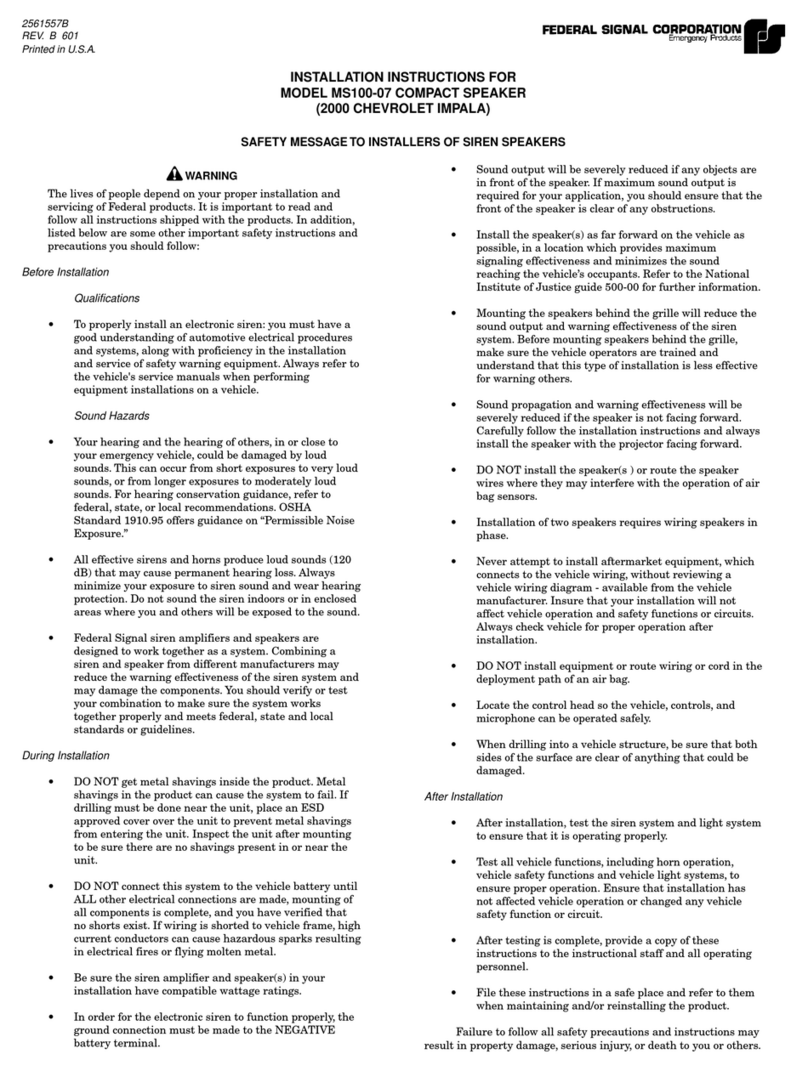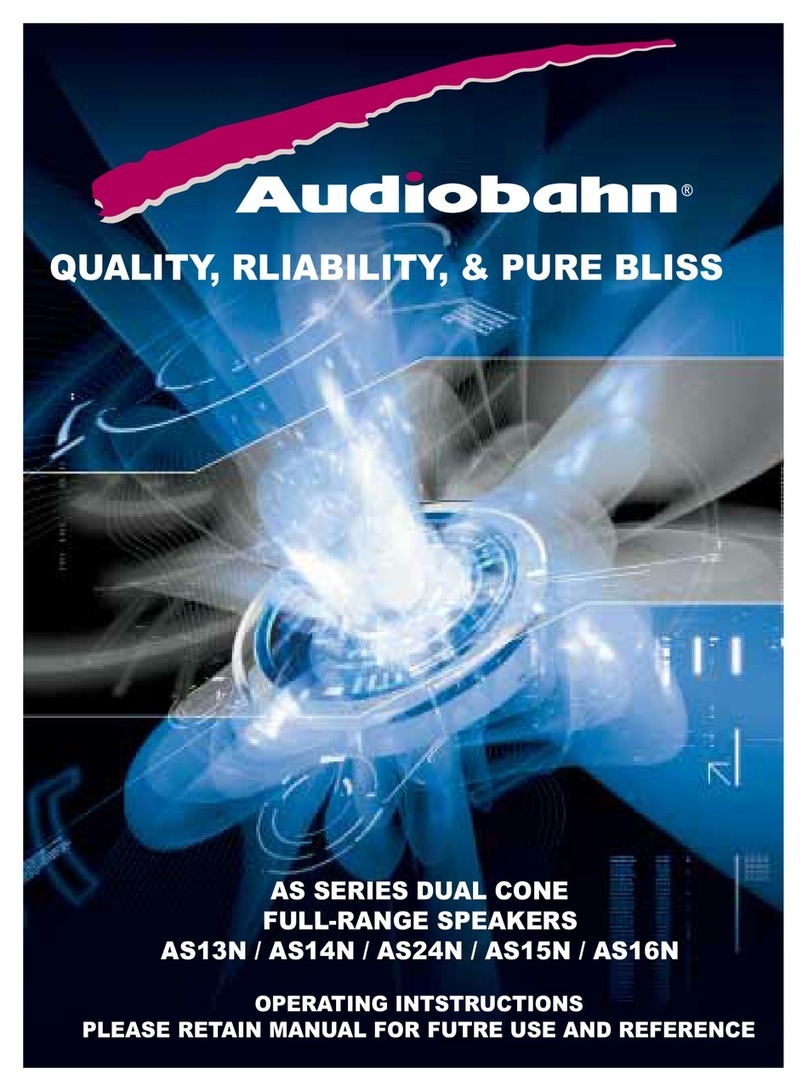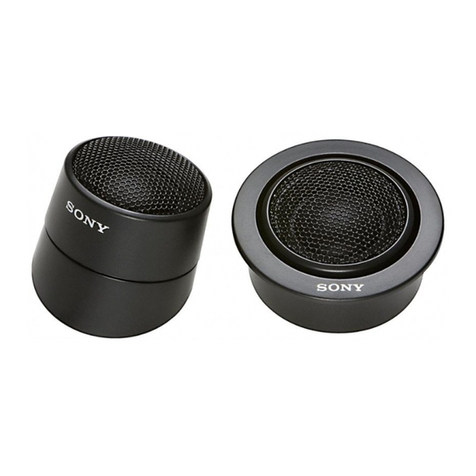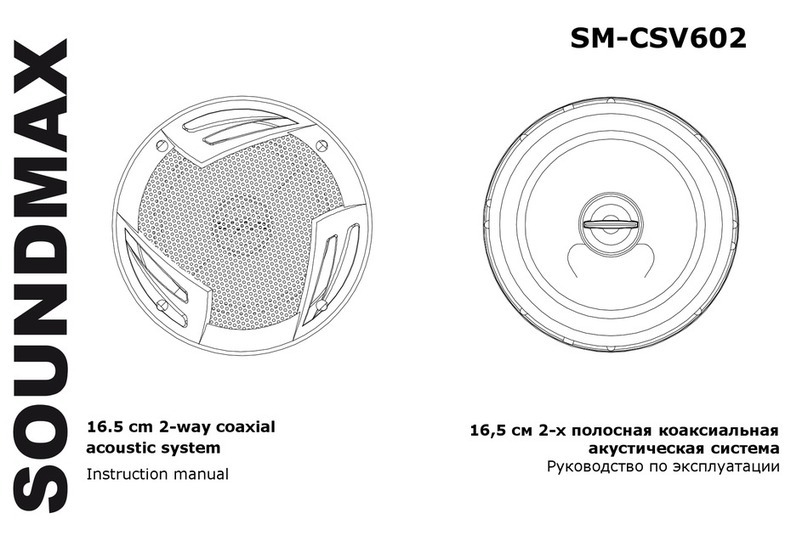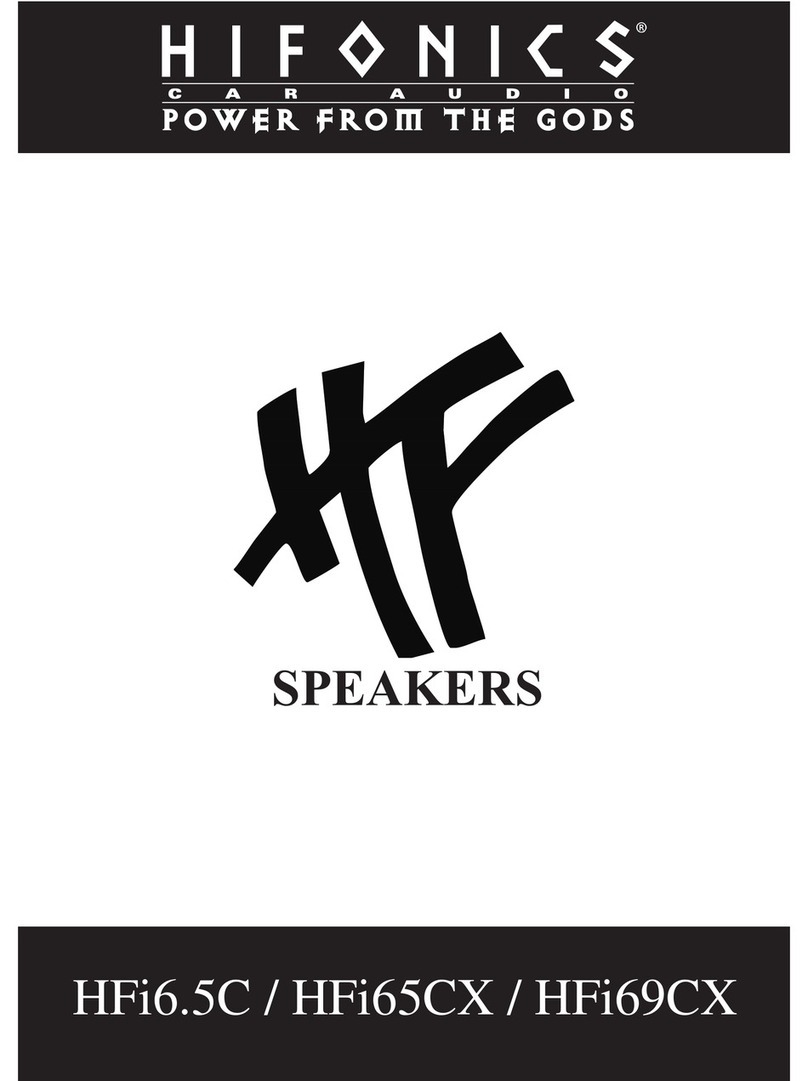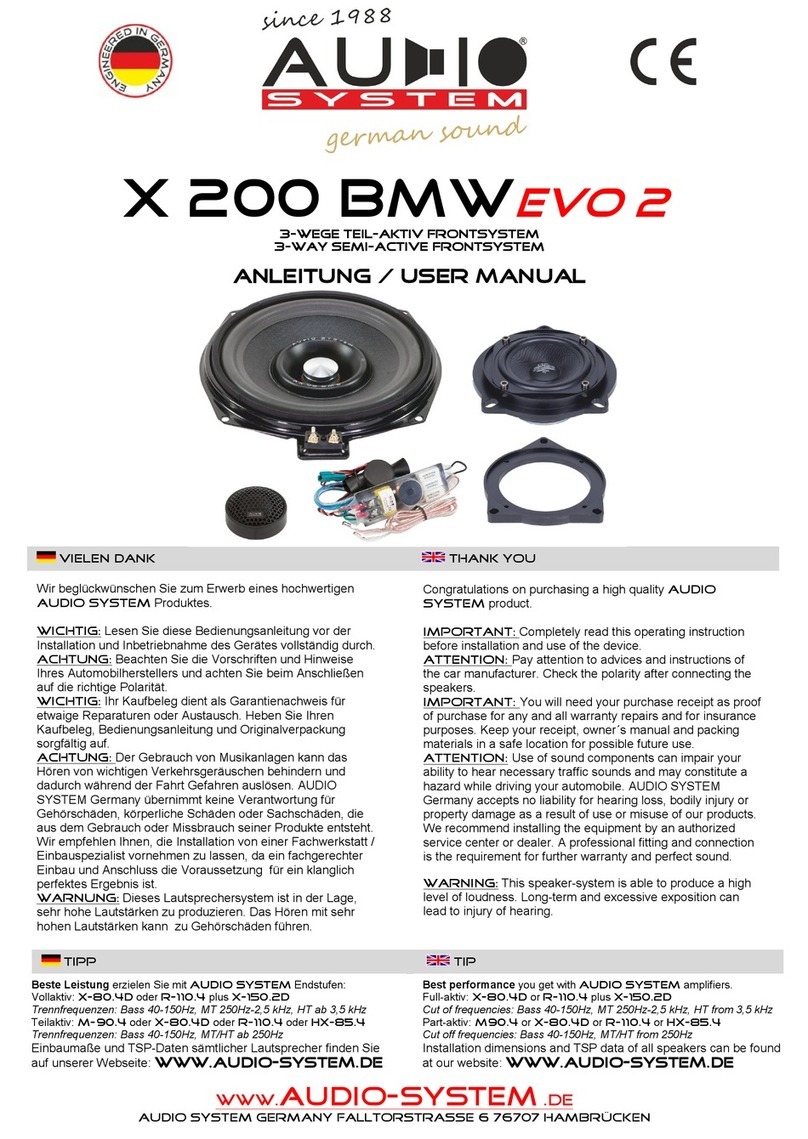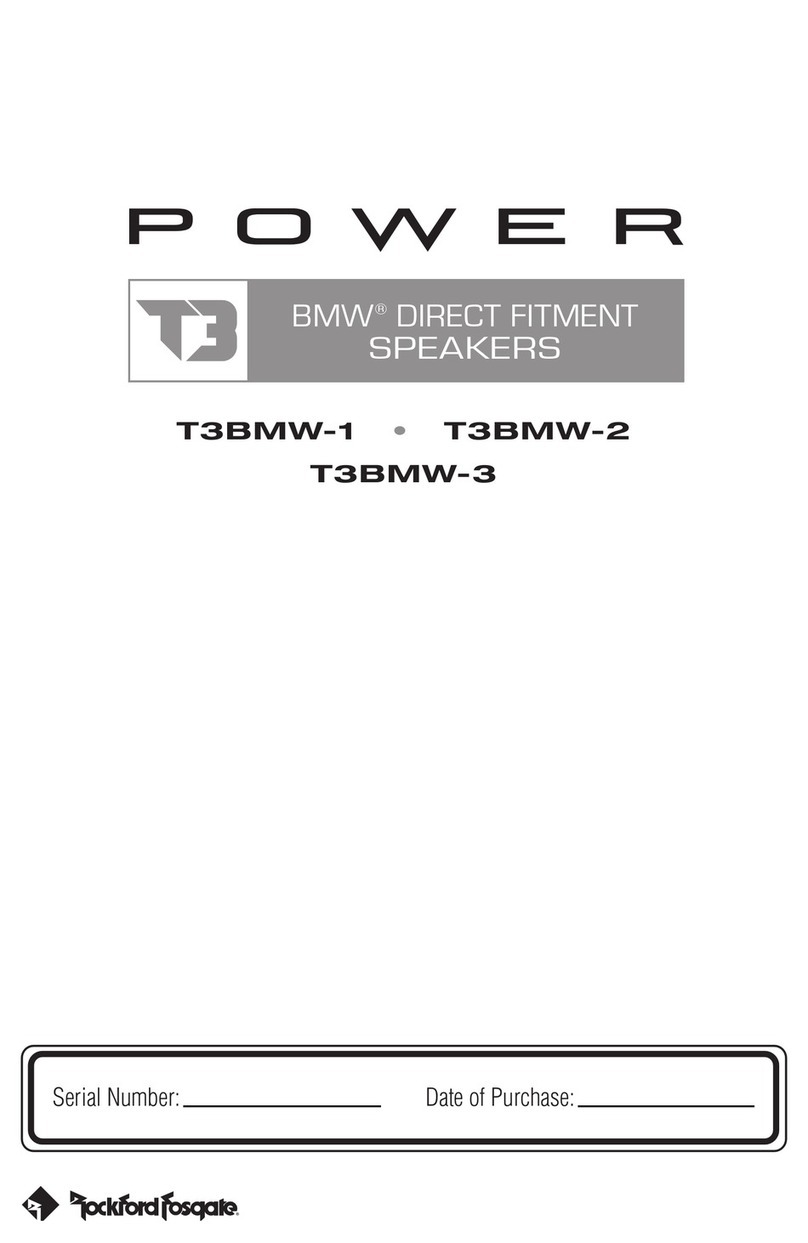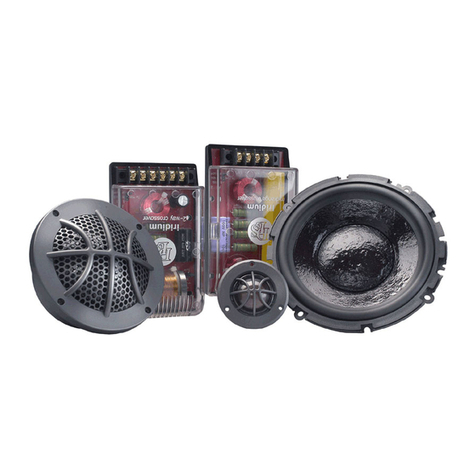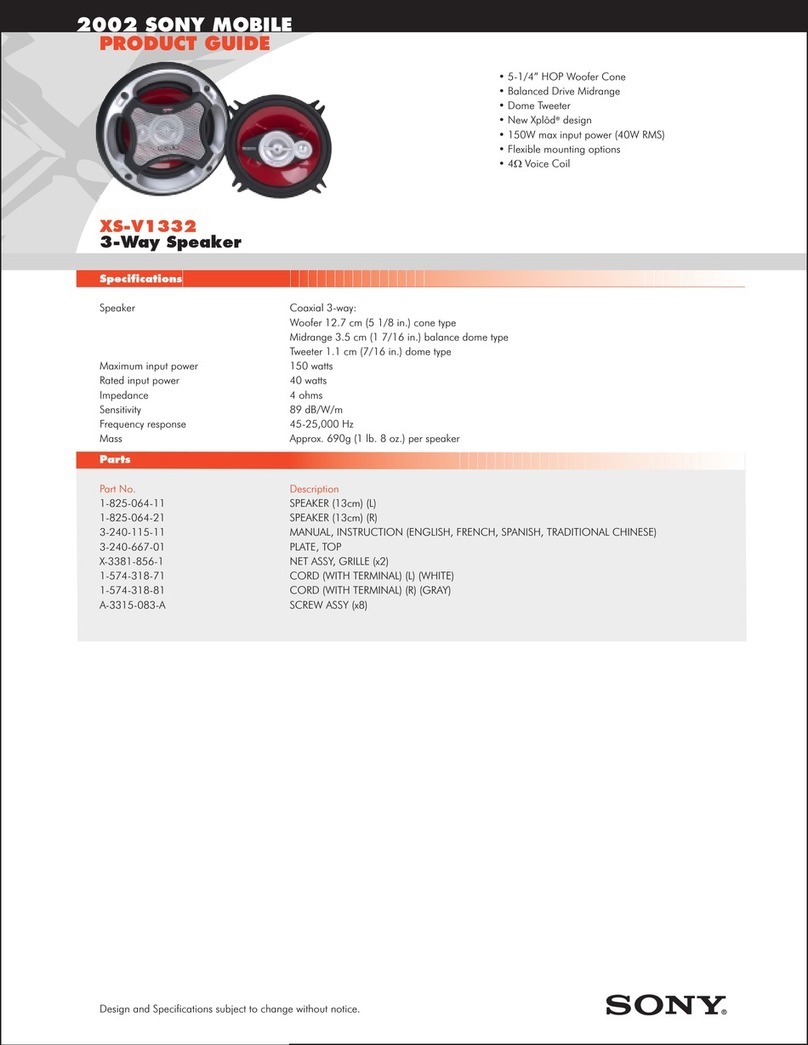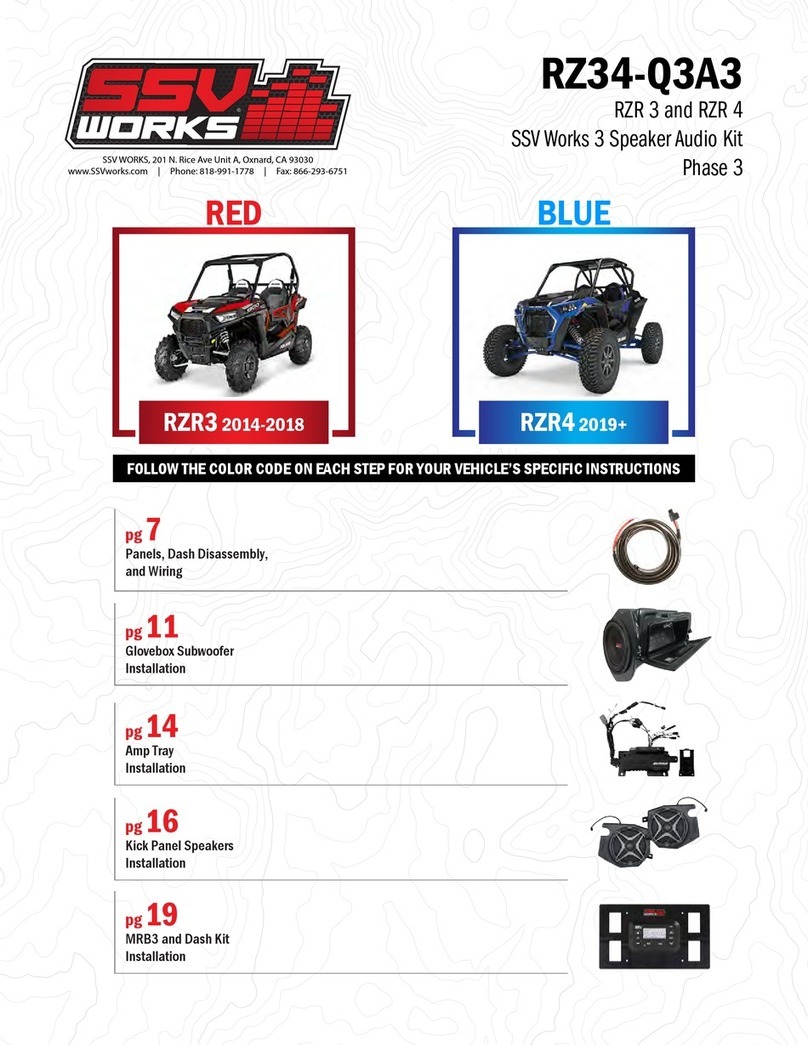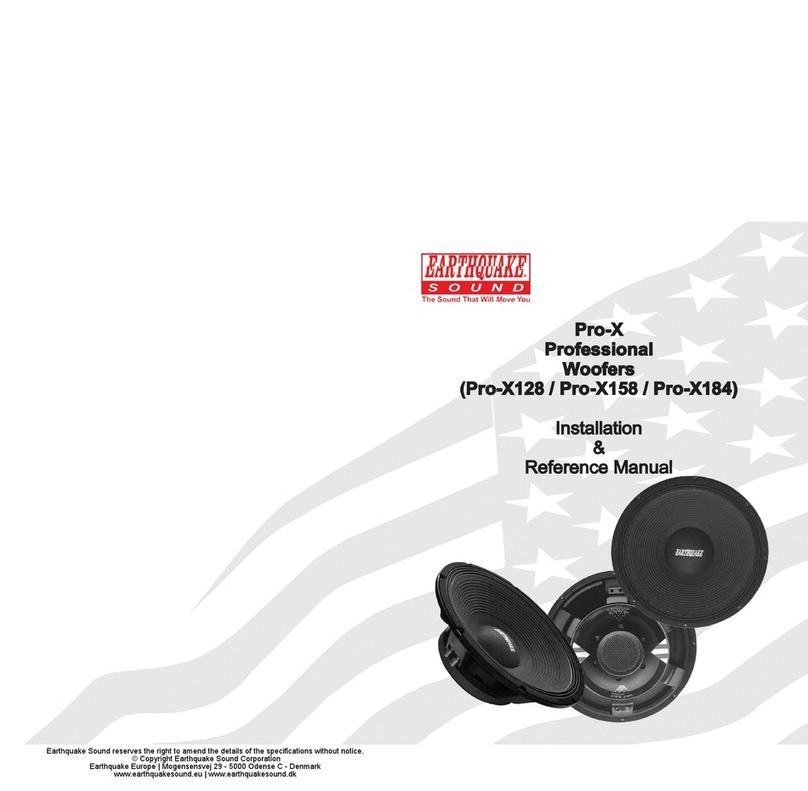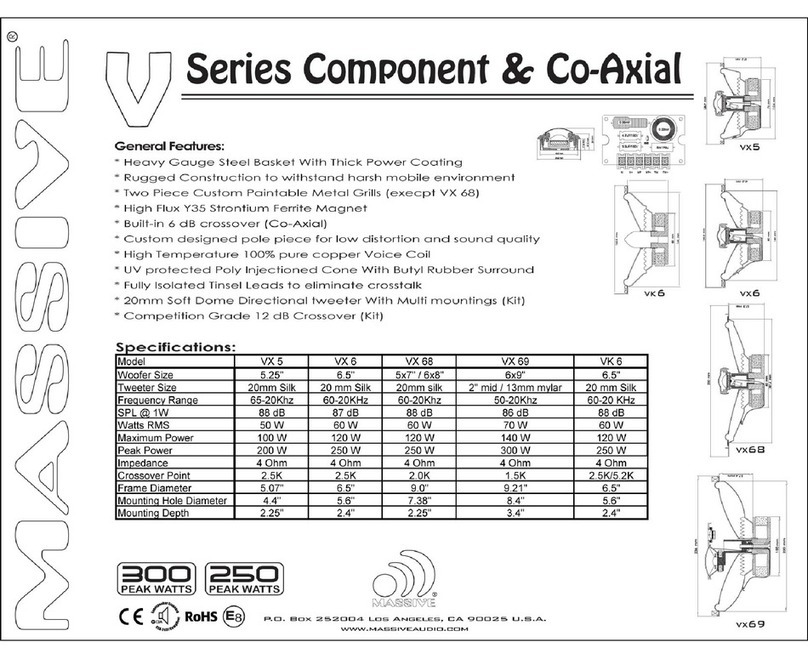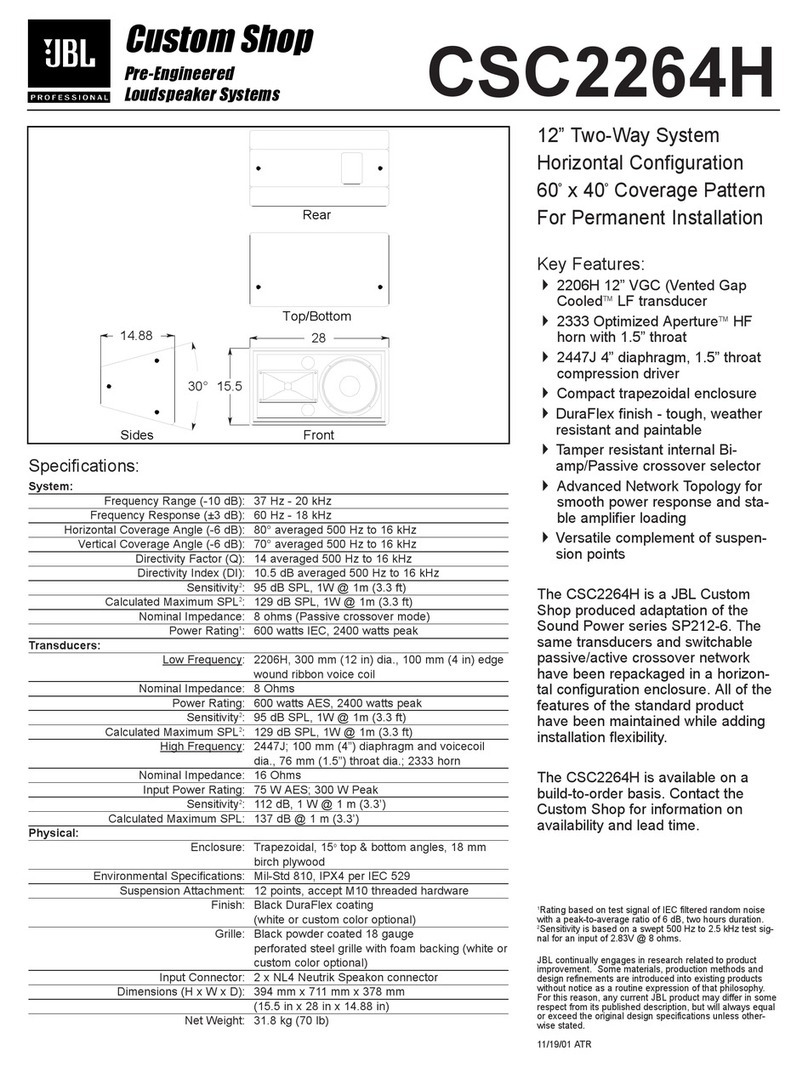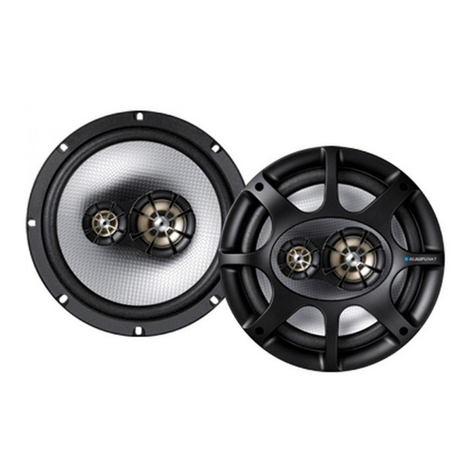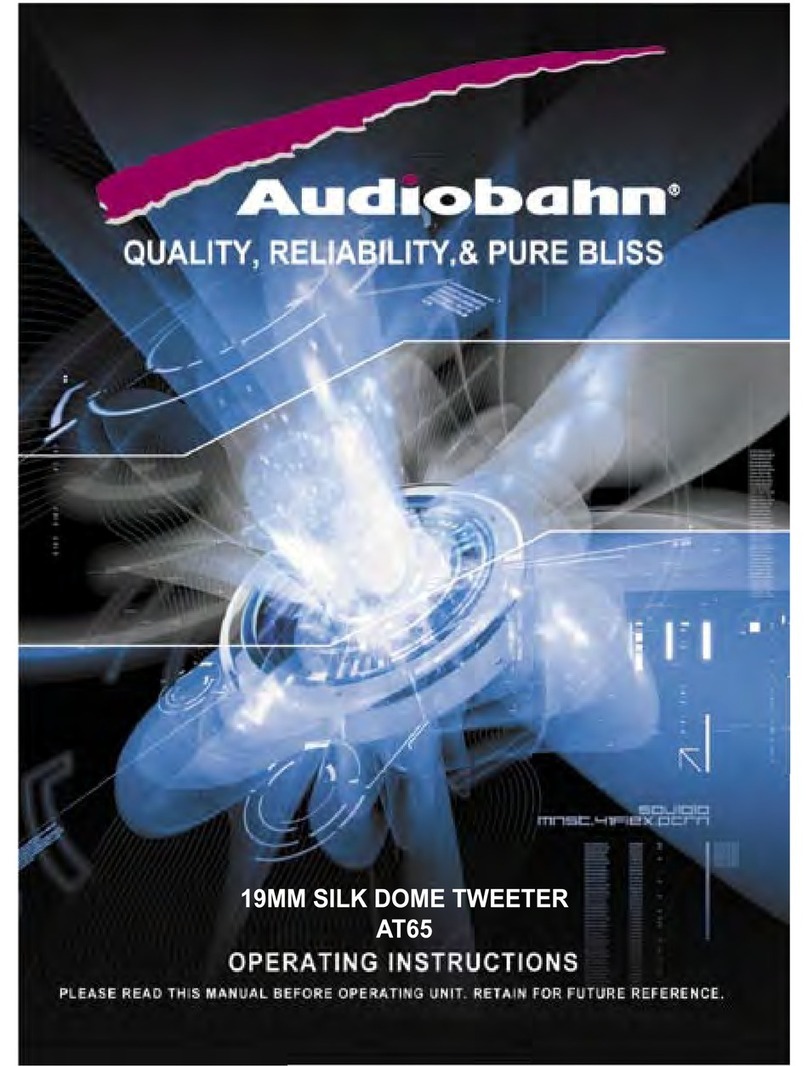Federal Signal Corporation MS100-03 User manual

2561397B
REV. B 601
Printed in U.S.A
.
INSTALLATION INSTRUCTIONS FOR
MODEL MS100-03 COMPACT SPEAKER
(1997 AND NEWER CHEVROLET LUMINA)
SAFETY MESSAGETO INSTALLERS OF SIREN SPEAKERS
WARNING
The lives of people depend on your proper installation and
servicing of Federal products. It is important to read and
follow all instructions shipped with the products. In addition,
listed below are some other important safety instructions and
precautions you should follow:
Before Installation
Qualifications
• To properly install an electronic siren: you must have a
good understanding of automotive electrical procedures
and systems, along with proficiency in the installation
and service of safety warning equipment. Always refer to
the vehicle's service manuals when performing
equipment installations on a vehicle.
Sound Hazards
• Your hearing and the hearing of others, in or close to
your emergency vehicle, could be damaged by loud
sounds. This can occur from short exposures to very loud
sounds, or from longer exposures to moderately loud
sounds. For hearing conservation guidance, refer to
federal, state, or local recommendations. OSHA
Standard 1910.95 offers guidance on “Permissible Noise
Exposure.”
• All effective sirens and horns produce loud sounds (120
dB) that may cause permanent hearing loss. Always
minimize your exposure to siren sound and wear hearing
protection. Do not sound the siren indoors or in enclosed
areas where you and others will be exposed to the sound.
• Federal Signal siren amplifiers and speakers are
designed to work together as a system. Combining a
siren and speaker from different manufacturers may
reduce the warning effectiveness of the siren system and
may damage the components. You should verify or test
your combination to make sure the system works
together properly and meets federal, state and local
standards or guidelines.
During Installation
• DO NOT get metal shavings inside the product. Metal
shavings in the product can cause the system to fail. If
drilling must be done near the unit, place an ESD
approved cover over the unit to prevent metal shavings
from entering the unit. Inspect the unit after mounting
to be sure there are no shavings present in or near the
unit.
• DO NOT connect this system to the vehicle battery until
ALL other electrical connections are made, mounting of
all components is complete, and you have verified that
no shorts exist. If wiring is shorted to vehicle frame, high
current conductors can cause hazardous sparks resulting
in electrical fires or flying molten metal.
• Be sure the siren amplifier and speaker(s) in your
installation have compatible wattage ratings.
• In order for the electronic siren to function properly, the
ground connection must be made to the NEGATIVE
battery terminal.
• Sound output will be severely reduced if any objects are
in front of the speaker. If maximum sound output is
required for your application, you should ensure that the
front of the speaker is clear of any obstructions.
• Install the speaker(s) as far forward on the vehicle as
possible, in a location which provides maximum
signaling effectiveness and minimizes the sound
reaching the vehicle’s occupants. Refer to the National
Institute of Justice guide 500-00 for further information.
• Mounting the speakers behind the grille will reduce the
sound output and warning effectiveness of the siren
system. Before mounting speakers behind the grille,
make sure the vehicle operators are trained and
understand that this type of installation is less effective
for warning others.
• Sound propagation and warning effectiveness will be
severely reduced if the speaker is not facing forward.
Carefully follow the installation instructions and always
install the speaker with the projector facing forward.
• DO NOT install the speaker(s ) or route the speaker
wires where they may interfere with the operation of air
bag sensors.
• Installation of two speakers requires wiring speakers in
phase.
• Never attempt to install aftermarket equipment, which
connects to the vehicle wiring, without reviewing a
vehicle wiring diagram - available from the vehicle
manufacturer. Insure that your installation will not
affect vehicle operation and safety functions or circuits.
Always check vehicle for proper operation after
installation.
• DO NOT install equipment or route wiring or cord in the
deployment path of an air bag.
• Locate the control head so the vehicle, controls, and
microphone can be operated safely.
• When drilling into a vehicle structure, be sure that both
sides of the surface are clear of anything that could be
damaged.
After Installation
• After installation, test the siren system and light system
to ensure that it is operating properly.
• Test all vehicle functions, including horn operation,
vehicle safety functions and vehicle light systems, to
ensure proper operation. Ensure that installation has
not affected vehicle operation or changed any vehicle
safety function or circuit.
• After testing is complete, provide a copy of these
instructions to the instructional staff and all operating
personnel.
• File these instructions in a safe place and refer to them
when maintaining and/or reinstalling the product.
Failure to follow all safety precautions and instructions may
result in property damage, serious injury, or death to you or others.

290A3301
RADIATOR
CROSSBAR
1/4" SPLIT LOCKWASHERS(2)
1/4-20 x 5/8" HEX WSH. HD. SELF
THREADING SCREWS(2)
5/16-18 x 1" OR
3/8-16 x 1" HEX HD.
CAP SCREW(1)
3/8" SPLIT OR 5/16" SPLIT
LOCKWASHER(1)
BUMPER
PASSENGER
SIDE HEADLIGHT
3/8" FLAT OR 5/16" FLAT
WASHER(1)
Figure 3.
CAUTION
Before drilling holes in ANY part of a vehicle, be sure that
both sides of the mounting surface are clear of parts that
could be damaged; such as brake lines, fuel lines, electrical
wiring or other vital parts.
6. Drill two 3/16" holes in the radiator crossbar at the drill
position marks.
7. Remove and discard the hex head bolt from the front of the
motor-mount bracket.
8. See figure 3. Place the speaker/bracket assembly in position
between the radiator and grille. If necessary, adjust the speaker on the
bracket to avoid interference on the speaker sides.
9. For the 1995 Lumina, secure the speaker/bracket assembly
to the top of the radiator crossbar using the 1/4 x 5/8" thread-forming
bolts. Secure the speaker/bracket assembly to the front of the radiator
crossbar using the 3/8-16 x 1" bolt, 3/8" flat washer, and 3/8" lockwasher
as shown in figure 3.
-2-
A. GENERAL.
The Model MS100 is a compact speaker designed to be mounted
using the supplied bracket.
If the MS100 is installed using another mounting system, the
safety and effectiveness of the installation must be carefully evaluated.
B. UNPACKING.
After unpacking the kit, carefully check all envelopes, shipping
labels, and tags before removing or destroying them. Ensure that the
parts listed in the KIT CONTENTS LIST are contained in the packing
carton.
C. KIT CONTENTS LIST.
Qty. Description Part Number
1 Speaker Assembly MS100
1 Bracket, Speaker Mounting 8567075
1 Bolt, 3/8-16 7002A007-16
1 Bolt, 5/16-18 7002A004-16
2 Screw, 1/4" X 5/8", Type B 7011165-10
1 Washer, Flat, 3/8" 7072A034
1 Washer, Flat, 5/16" 7072A030
1 Lockwasher, Split, 3/8" 7074A046
3 Lockwasher, Split, 5/16" 7074A020
2 Lockwasher, Split, 1/4" 7074A015
2 Screw, 5/16-18 7002A005-12
D. INSTALLATION.
WARNING
To avoid reduction of sound output and damage to speaker,
ensure that speaker is mounted with wires protruding from
the right side of the speaker when viewing it from the front.
1. See figure 1. Assemble the speaker mounting bracket to the
speaker using the bolts and lockwashers supplied. Position the back of
the speaker parallel with the bracket’s vertical back wall, and tighten
the 5/16-18 x 3/4" bolts securely.
2. Raise the vehicle hood. See figure 2. Locate the plastic panel
between the radiator crossbar and the grille.
3. Remove and retain the three plastic rivets and two hex head
screws. Unlatch the rubber fasteners at each end of the panel (see
figure 2). Remove the plastic panel.
4. See figure 2. Locate the passenger side motor mount bracket.
5. See figure 3. Place the speaker/bracket assembly over the
passenger-side motor-mount bracket. Using the bracket as a template,
scribe two drill position marks on the radiator crossbar.
290A330
0
MOTOR MOUNT
BRACES
RADIATOR
CROSSBAR
LATCH
LATCH
BUMPER
3 PLASTIC
RIVETS
HEADLIGHT
PLASTIC
PANEL
Figure 2.
290A3299B
MS100
(SEE NOTE) SPEAKER MOUNTING
BRACKET(1)
5/16" SPLIT
LOCKWASHERS(2)
NOTE: MS100 MUST BE MOUNTED WITH WIRE
LEADS PROTRUDING FROM THE SIDE AS SHOWN.
5/16-18 x 3/4"
HEX HEAD
BOLTS (2)
5/16-18 x 3/4"
HEX HEAD
BOLTS (2)
Figure 1.

For the 1996 and newer Luminas, secure the speaker/bracket
assembly to the top of the radiator crossbar using the 1/4 x 5/8" thread-
forming bolts. Secure the speaker/bracket assembly to the front of the
radiator crossbar using the 5/16-18 x 1" bolt, 5/16" flat washer, and 5/
16" lockwasher as shown in figure 3.
10. Replace the plastic panel and latch the rubber fasteners at
each end of the panel. Install the two hex head screws and three plastic
rivets.
CAUTION
Before drilling holes in ANY part of a vehicle, be sure that
both sides of the mounting surface are clear of parts that
could be damaged; such as brake lines, fuel lines, electrical
wiring or other vital parts.
If the plastic rivets cannot be reused, drill two 3/16" holes
through the plastic panel into the front of the radiator crossbar. Secure
the panel in position using two 1/4 x 5/8" thread-forming screws and
lockwashers.
11. Connect the two leads from the speaker to the electronic
siren’s speaker cable. Refer to the instruction sheet packed with the
electronic siren for additional details.
WARNING
All effective sirens and horns produce loud sounds (120 dB)
that may cause permanent hearing loss. Always minimize
your exposure to siren sound and wear hearing protection. Do
not sound the siren indoors or in enclosed areas where you
and others will be exposed to the sound.
12. Test the speaker for proper operation.
E. SERVICE.
Opening the unit will void the warranty. This speaker has no field
serviceable parts. The factory can and will service your speaker. If you
are experiencing problems with the speaker, send it to:
Service Department
Federal Signal Corporation
2645 Federal Signal Drive
University Park, IL 60466
SAFETY MESSAGETO PERSONNEL SERVICING FEDERAL SIGNAL
SIREN SPEAKERS
WARNING
The lives of people depend on your proper servic-
ing of Federal products. It is important to read
and follow all instructions shipped with the
products. In addition, listed below are some
other safety instructions and precautions you
should follow:
• Read and understand all instructions in this manual before
servicing the electronic siren or speaker.
• To properly service an electronic siren or speaker: you must
have a good understanding of automotive electrical proce-
dures and systems, along with proficiency in the installation
and service of safety warning equipment. Always refer to the
vehicle's service manuals when performing service on a
vehicle.
• Electronic circuit and speaker repairs must be performed by
a qualified and competent electronic technician.
• Your hearing and the hearing of others, in or close to your
emergency vehicle, could be damaged by loud sounds. This
can occur from short exposures to very loud sounds, or from
longer exposures to moderately loud sounds. For hearing
conservation guidance, refer to federal, state, or local
recommendations. OSHA Standard 1910.95 offers guidance
on “Permissible Noise Exposure.”
• All effective sirens and horns produce loud sounds (120 dB)
that may cause permanent hearing loss. Always minimize
your exposure to siren sound and wear hearing protection. Do
not sound the siren indoors or in enclosed areas where you
and others will be exposed to the sound.
• DO NOT connect this system to the positive terminal of the
battery until servicing is complete, and you have verified that
there are no short circuits to ground.
• In order for the electronic siren to function properly, the
ground connection must be made to the NEGATIVE battery
terminal.
• After repair, test the electronic siren and speaker system to
ensure that it is operating properly.
• Federal Signal siren amplifiers and speakers are designed to
work together as a system. Combining a siren and speaker
from different manufacturers may reduce the warning
effectiveness of the siren system and may damage the
components. You should verify or test your combination to
make sure the system works together properly and meets
both federal, state and local standards or guidelines.
Failure to follow all safety precautions and instructions may
result in property damage, serious injury, or death to you or others.
-3-

-4-
SAFETY MESSAGETO OPERATORS OF
FEDERAL SIGNAL ELECTRONIC SIRENS
AND LIGHT/SOUND SYSTEMS
WARNING
The lives of people depend on your safe operation of Federal
products. It is important to read and follow all instructions
shipped with the products. In addition, listed below are some
other important safety instructions and precautions you
should follow:
Qualifications
• To properly use an electronic siren and speaker(s): you must
have a good understanding of general vehicle operation, a
high proficiency in the use of safety warning equipment, and
thorough knowledge of state and federal UNIFORM
TRAFFIC CODES.
Sound Hazards
• Your hearing and the hearing of others, in or close to your
emergency vehicle, could be damaged by loud sounds. This
can occur from short exposures to very loud sounds, or from
longer exposures to moderately loud sounds. For hearing
conservation guidance, refer to federal, state, or local
recommendations. OSHA Standard 1910.95 offers guidance
on “Permissible Noise Exposure.”
• All effective sirens and horns produce loud sounds (120 dB)
that may cause permanent hearing loss. Always minimize
your exposure to siren sound, roll up your windows and wear
hearing protection. Do not sound the siren indoors or in
enclosed areas where you and others will be exposed to the
sound. Only use the siren for emergency response situations.
Sound Limitations
• Before using the vehicle, check to see if the siren speakers
are concealed from view. If the siren speaker is not in clear
view on the front of the vehicle, use extra caution when
operating the vehicle. A concealed siren speaker installation
is less effective at warning others.
• Maximum sound output will be severely reduced if any
objects are in front of the speaker. If your installation has
obstructions in front of the speaker, drive even more
cautiously.
• Frequently inspect the speaker to ensure that it is clear of
any obstruction, such as mud or snow, which will reduce
maximum sound output.
Signaling Limitations
• Be aware that the use of your visual and audible signaling
devices does not give you the right to force your way through
traffic. Your emergency lights, siren, and actions are
REQUESTING the right-of-way.
• Although your warning system is operating properly, it may
not alert everyone. People may not hear, see, or heed your
warning signal. You must recognize this fact and continue
driving cautiously.
• Situations may occur which obstruct your warning signal
when natural or man-made objects are between your vehicle
and others. This can also occur when you raise your hood or
trunk lid. If these situations occur, be especially careful.
Driving Limitations
• At the start of your shift, you should ensure that the light/
sound system is securely attached to the vehicle and
operating properly.
• If the unique combination of emergency vehicle equipment
installed in your vehicle has resulted in the siren controls
being installed in a position that does not allow you to
operate them by touch only, OPERATE CONTROLS ONLY
WHILE YOUR VEHICLE IS STOPPED.
• If driving conditions require your full attention, you should
avoid operating the siren controls while the vehicle is in
motion.
Continuing Education
• File these instructions in a safe place and refer to them
periodically. Give a copy of these instructions to new recruits
and trainees.
Failure to follow these safety precautions may result in property
damage, serious injury, or death to you, to passengers, or to others.
Other Federal Signal Corporation Car Speakers manuals
